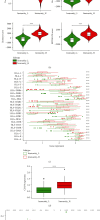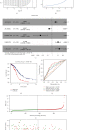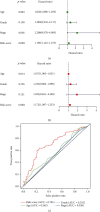Screening and Identification of an Immune-Associated lncRNA Prognostic Signature in Ovarian Carcinoma: Evidence from Bioinformatic Analysis
- PMID: 33997040
- PMCID: PMC8110384
- DOI: 10.1155/2021/6680036
Screening and Identification of an Immune-Associated lncRNA Prognostic Signature in Ovarian Carcinoma: Evidence from Bioinformatic Analysis
Abstract
Backgrounds: The dysregulated long noncoding RNAs (lncRNAs) have been described to be crucial regulators in the progression of ovarian carcinoma. The infiltration status of immune cells is also related to the clinical outcomes in ovarian carcinoma. The present research is aimed at constructing an immune-associated lncRNA signature with potential prognostic value for ovarian carcinoma patients.
Methods: We obtained 379 ovarian carcinoma cases with available clinical data and transcriptome data from The Cancer Genome Atlas database to evaluate the infiltration status of immune cells, thereby generating high and low immune cell infiltration groups. According to the expression of the immune-associated lncRNA signature, the risk score of each case was calculated. The high- and low-risk groups were classified using the median risk score as threshold.
Results: A total of 169 immune-associated lncRNAs that differentially expressed in ovarian carcinoma were included. According to the Lasso regression analysis and Cox univariate and multivariate analyses, 5 immune-associated lncRNAs, including AC134312.1, AL133467.1, CHRM3-AS2, LINC01722, and LINC02207, were identified as a predictive signature with significant prognostic value in ovarian carcinoma. The following Kaplan-Meier analysis, ROC analysis, and Cox univariate and multivariate analyses further suggested that the predicted signature may be an independent prognosticator for patients with ovarian carcinoma. The following gene set enrichment analysis showed that this 5 immune-associated lncRNAs signature was significantly related to the hedgehog pathway, basal cell carcinoma, Wnt signaling pathway, cytokine receptor interaction, antigen processing and presentation, and T cell receptor pathway.
Conclusion: : This study suggested a predictive model with 5 immune-associated lncRNAs that has an independent prognostic value for ovarian carcinoma patients.
Copyright © 2021 Yan Li et al.
Conflict of interest statement
The authors declare that they have no conflicts of interest.
Figures





Similar articles
-
A prognostic model based on immune-related long noncoding RNAs for patients with epithelial ovarian cancer.J Ovarian Res. 2022 Jan 15;15(1):8. doi: 10.1186/s13048-021-00930-w. J Ovarian Res. 2022. PMID: 35031063 Free PMC article.
-
Identification and validation of an individualized prognostic signature of lower-grade glioma based on nine immune related long non-coding RNA.Clin Neurol Neurosurg. 2021 Feb;201:106464. doi: 10.1016/j.clineuro.2020.106464. Epub 2021 Jan 5. Clin Neurol Neurosurg. 2021. PMID: 33454543
-
Identification of m6A methyltransferase-related lncRNA signature for predicting immunotherapy and prognosis in patients with hepatocellular carcinoma.Biosci Rep. 2021 Jun 25;41(6):BSR20210760. doi: 10.1042/BSR20210760. Biosci Rep. 2021. PMID: 34027555 Free PMC article.
-
Dysregulated Expression of Long Noncoding RNAs in Ovarian Cancer.Int J Gynecol Cancer. 2016 Nov;26(9):1564-1570. doi: 10.1097/IGC.0000000000000828. Int J Gynecol Cancer. 2016. PMID: 27603915 Free PMC article. Review.
-
Getting to know ovarian cancer: Focusing on the effect of LncRNAs in this cancer and the effective signaling pathways.Pathol Res Pract. 2024 Feb;254:155084. doi: 10.1016/j.prp.2023.155084. Epub 2024 Jan 4. Pathol Res Pract. 2024. PMID: 38244434 Review.
Cited by
-
Bioinformatic Analyses of the Ferroptosis-Related lncRNAs Signature for Ovarian Cancer.Front Mol Biosci. 2022 Jan 18;8:735871. doi: 10.3389/fmolb.2021.735871. eCollection 2021. Front Mol Biosci. 2022. PMID: 35127813 Free PMC article.
-
Silencing of lncRNA CHRM3-AS2 Expression Exerts Anti-Tumour Effects Against Glioma via Targeting microRNA-370-5p/KLF4.Front Oncol. 2022 Mar 11;12:856381. doi: 10.3389/fonc.2022.856381. eCollection 2022. Front Oncol. 2022. PMID: 35359381 Free PMC article.
-
Necroptosis-Associated lncRNA Prognostic Model and Clustering Analysis: Prognosis Prediction and Tumor-Infiltrating Lymphocytes in Breast Cancer.J Oncol. 2022 Apr 27;2022:7099930. doi: 10.1155/2022/7099930. eCollection 2022. J Oncol. 2022. PMID: 35528236 Free PMC article.
-
Development and verification of a 7-lncRNA prognostic model based on tumor immunity for patients with ovarian cancer.J Ovarian Res. 2023 Feb 4;16(1):31. doi: 10.1186/s13048-023-01099-0. J Ovarian Res. 2023. PMID: 36739404 Free PMC article.
-
Body Weight Is a Valid Predictor of the Long-Term Prognosis of Cervical Cancer.Comput Math Methods Med. 2022 Jun 8;2022:5613350. doi: 10.1155/2022/5613350. eCollection 2022. Comput Math Methods Med. 2022. PMID: 35720030 Free PMC article.
References
MeSH terms
Substances
LinkOut - more resources
Full Text Sources
Other Literature Sources
Medical

